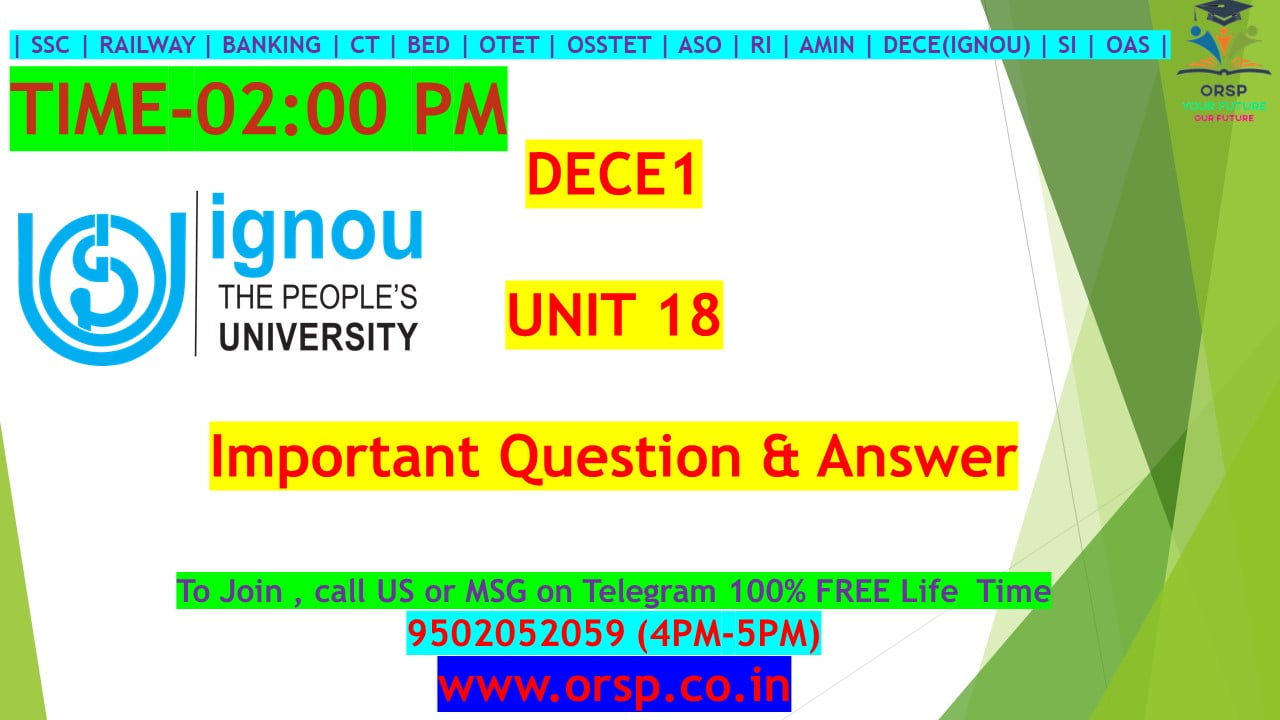| DECE1 | Unit 18 | Important Question & Answer | IGNOU | ORSP |
DEVELOPING COGNITIVE ABILITIES
AND
UNDERSTANDING CONCEPTS
संज्ञानात्मक क्षमताओं का विकास
तथा
अवधारणाओं को समझना
Structure
Introduction
Symbolic Thought and Fantasy
Some Cognitive Abilities
- Taking Another Person’s Perspective
- Matching
- Identifying Common Relations
- Conservation
- Classification/Grouping
- Seriation
- Understanding Cause and Effect Relationships
Animism
Acquiring Concepts
- Concept of Number
- Other Concepts
The Emerging Reasoning Skills
Check Your Progress Exercise 1
1) Read the following statements carefully. Each of them is incomplete. Along with the statements choices have been given, one of which is the most appropriate. Tick the appropriate answer to each statement.
i) The cognitive ability that indicates the beginning of the pre-operational period is
a) ability for symbolic thinking ( Right)
b) ability for goal-directed behaviour (Emergence in sensorimotor period )
c) ability to take another person’s perspective (Emergence in the preschool year )
ii) Pretend games
a) become more elaborate and complex as the child grows older ( Right)
b) become simpler as the child grows older
c) played by three year olds are same in complexity as those played by six year olds 0
iii) Playing pretend games, the development of language and drawing – all these three abilities are evidence of
a) egocentric thinking
b) reflexes
c) symbolic thinking ( Right)
iv) Egocentric thinking refers to
a) understanding another person’s emotions and responding to them appropriately
b) the ability to play pretend games
c) looking at things entirely from one’s own frame of reference, from one’s own perspective ( Right)
v) Preschoolers
a) are completely egocentric
b) are not egocentric at all
c) can at times consider the other person’s perspective but in most of the situations they behave egocentrically ( Right)
i) पूर्व-संचालन अवधि की शुरुआत को इंगित करने वाली संज्ञानात्मक क्षमता है
a) प्रतीकात्मक सोच की क्षमता
बी) लक्ष्य-निर्देशित व्यवहार की क्षमता (सेंसिमोटर अवधि में उभरना)
ग) किसी अन्य व्यक्ति के दृष्टिकोण को लेने की क्षमता (पूर्वस्कूली वर्ष में उभरना)
ii) प्रेटेंड गेम्स
a) जैसे-जैसे बच्चा बड़ा होता है, अधिक विस्तृत और जटिल होता जाता है (दाएं)
b) जैसे-जैसे बच्चा बड़ा होता है, सरल होता जाता है
ग) तीन साल के बच्चों द्वारा खेला गया जटिलता में वही है जो छह साल के बच्चों द्वारा खेला जाता है 0
iii) ढोंग खेल खेलना, भाषा का विकास और चित्र बनाना – ये तीनों क्षमताएँ किसका प्रमाण हैं?
ए) अहंकारी सोच
बी) सजगता
सी) प्रतीकात्मक सोच
iv) अहंकारी सोच का अर्थ है
a) किसी अन्य व्यक्ति की भावनाओं को समझना और उनका उचित रूप से जवाब देना
बी) ढोंग खेल खेलने की क्षमता
ग) चीजों को पूरी तरह से अपने संदर्भ के फ्रेम से, अपने स्वयं के दृष्टिकोण से देखना
v) प्रीस्कूलर
ए) पूरी तरह से अहंकारी हैं
बी) बिल्कुल भी अहंकारी नहीं हैं
ग) कभी-कभी दूसरे व्यक्ति के दृष्टिकोण पर विचार कर सकते हैं लेकिन अधिकांश स्थितियों में वे अहंकारी रूप से व्यवहार करते हैं
Check Your Progress Exercise 2
1) The following six statements describe situations which reflect the cognitive abilities of preschoolers. Each statement reflects one ability. Identify the ability each statement describes. To help you, the abilities have been written below.
seriation
grouping
matching
common relations
cause and effect
i) When the preschooler picks out two pencils that are exactly the same in all respects, from a
collection of five pencils, she is showing the ability of . matching
जब प्रीस्कूलर दो पेंसिलों को चुनता है जो सभी तरह से बिल्कुल समान हैं, तो yeसे पांच पेंसिलों का संग्रह, वह दिखा रही है की क्षमता मेल मिलाना
ii) When the six year old tells her friends, “those who want to play outside stand on this side
and those who don’t, stand on the other”, she is showing the PLAY ability of grouping/classification
जब छह साल की बच्ची अपने दोस्तों से कहती है, “जो लोग बाहर खेलना चाहते हैं वे इस तरफ खड़े हो जाते हैं”
और जो नहीं करते हैं, वे दूसरे पर खड़े होते हैं”, वह समूह/वर्गीकरण की खेलने की क्षमता दिखा रही है
iii) When five preschoolers on being asked to stand in a line height-wise, so that the tallest is
in front and the shortest behind, can do so with some prompting, they are using the ability of
seriation
जब पांच प्रीस्कूलर को ऊंचाई के अनुसार एक पंक्ति में खड़े होने के लिए कहा जाता है, ताकि सबसे लंबा हो
आगे और पीछे सबसे छोटा, कुछ प्रोत्साहन के साथ ऐसा कर सकते हैं, वे की क्षमता का उपयोग कर रहे हैं
क्रमबद्धता
iv) When the preschooler remarks that “clothes dry faster in the sun”, she is showing an
understanding of cause and effect
जब प्रीस्कूलर टिप्पणी करता है कि “कपड़े धूप में तेजी से सूखते हैं”, तो वह दिखा रही है कारण और प्रभाव की समझ
v) When the preschooler tells her brother, “The faster you move the bicycle, the sooner we will
reach there”, or “Drive fast! We will reach there earlier”, she is showing an understanding of cause and effect
जब प्रीस्कूलर अपने भाई से कहती है, “आप जितनी तेज़ी से साइकिल चलाएंगे, हम उतनी ही तेज़ी से आगे बढ़ेंगे
वहाँ पहुँचें”, या “तेज़ गति से चलाएँ! हम वहां पहले पहुंचेंगे”, वह कारण और प्रभाव की समझ दिखा रही है
vi) At lunch time at home when the five year old places one glass each in front of her mother and her sister and says,”Mummy is bigger, so big glass for her, Didi is small, so small glass for her”, she is showing the ability to understand
common relations
घर पर लंच के समय जब पांच साल की बच्ची अपनी मां और अपनी बहन के सामने एक-एक गिलास रखती है और कहती है, “माँ बड़ी है, उसके लिए इतना बड़ा गिलास, दीदी छोटी है, उसके लिए इतना छोटा गिलास”, वह दिखा रही है समझने की क्षमता
सामान्य संबंध
Conservation
the understanding that the amount of a substance remains the same even if its shape is changed, so
long as nothing is added to it or subtracted from it.
संरक्षण
यह समझ कि किसी पदार्थ का आकार बदलने पर भी उसकी मात्रा वही रहती है, इसलिए जब तक इसमें कुछ भी नहीं जोड़ा या घटाया जाता है।
Animism
the belief that all things are living and have intentions and feelings just as we do.
बचाव
यह किसी भी वस्तु के रूप में पैदा हुआ है, इसलिए जब तक मूवी कुछ अतिरिक्त जोड़ दिया जाए।
Classification
grouping objects together on the basis of some common properties between them.
वर्गीकरण
वस्तुओं को उनके बीच कुछ सामान्य गुणों के आधार पर एक साथ समूहित करना।
Matching
identifying objects that are exactly identical from a collection of objects.
मेल मिलाना
वस्तुओं के संग्रह से बिल्कुल समान वस्तुओं की पहचान करना।
Common relations
identifying the common relation between a pair of objects.
सामान्य संबंध
वस्तुओं की एक जोड़ी के बीच सामान्य संबंध की पहचान करना।
Seriation
ability to manage items in terms of gradation of size.
क्रमबद्धता
आकार के क्रम में वस्तुओं का प्रबंधन करने की क्षमता।
Check Your Progress Exercise 3
1) What are the four aspects that are involved in forming the concept of number? Answer briefly in the space provided below.
Acquiring the concept of number involves understanding that each number signifies a quantity, understanding one-to-onecorrespondence, understanding conservation of number and knowing the correct sequence of numbers.
Understanding that each number signifies a quantity
the child has to learn that the number one always signifies one item, number two signifies two items
and so forth. In other words, she has to learn that every number signifies a certain quantity
and that this remains the same in all contexts.
Understanding one-to-one correspondence
she has to understand one-to-one correspondence. She must know the correct sequence of numbers.
younger preschoolers are not able to give the exact number of objects as asked is because they have not understood one-to-one correspondence. They count one object twice or two objects as one, thus making an error.
Piaget and later researchers have conducted many experiments to find out how the understanding of one-to-one correspondence
One such experiment carried out with children between four and seven years of age is as follows. A row of objects, for example, a row of glasses, is placed in front of the child and she is asked to pick up glasses from a nearby pile and make a row that corresponds to the existing one. To do this the child has to keep one glass in front of each glass in the earlier row. The younger preschoolers make the new row as long as the existing one but without paying any attention that the number of glasses in this row should be the .same as in the earlier one. They just concentrate on the space occupied by the objects.
If the row which has less glasses is made to look longer than the second row. by spacing the glasses further apart in it, they feel that this row has more glasses than the second row. This means they do no1 have an idea of one-to-one correspondence
Understanding conservation of number
the concept that the number of objects remains the same even if they are grouped differently. For example, if there are five flowers, their number remains the same whether they are clustered together or spread out. A different arrangement of objects does not change their number.
knowing the correct sequence of numbers.
The child must know them in the sequence of 1,2,3,4, … This involves the understanding that each number name denotes a quantity which is one more than the uantity denoted by the previous number name. In other words, this involves some understanding of the concept of seriation .
Example
Ask three year olds to count aloud. Almost all of them are likely to begin proudly with, “one, two, three”, and then confidently go on to say, “five, six, nine, ten”. Ask them to repeat again and you will hear a different version altogether. They begin correctly with one, two and probably three, but then some numbers will be missed in the sequence and some will be counted out of place .
This means here the child not know correct sequence of number.
संख्या की अवधारणा के निर्माण में कौन से चार पहलू शामिल हैं? नीचे दिए गए स्थान में संक्षेप में उत्तर दें।
संख्या की अवधारणा को प्राप्त करने में यह समझना शामिल है कि प्रत्येक संख्या एक मात्रा को दर्शाती है, एक-से-एक पत्राचार को समझना, संख्या के संरक्षण को समझना और संख्याओं के सही क्रम को जानना।
यह समझना कि प्रत्येक संख्या एक मात्रा को दर्शाती है
बच्चे को यह सीखना होगा कि नंबर एक हमेशा एक आइटम को दर्शाता है, नंबर दो दो आइटम को दर्शाता है
इत्यादि। दूसरे शब्दों में, उसे यह सीखना होगा कि प्रत्येक संख्या एक निश्चित मात्रा को दर्शाती है
और यह कि यह सभी संदर्भों में समान रहता है।
एक-से-एक पत्राचार को समझना
उसे एक-से-एक पत्राचार को समझना होगा। उसे संख्याओं का सही क्रम पता होना चाहिए।
छोटे प्रीस्कूलर पूछे गए ऑब्जेक्ट्स की सटीक संख्या देने में सक्षम नहीं हैं क्योंकि उन्होंने एक-से-एक पत्राचार को नहीं समझा है। वे एक वस्तु को दो बार या दो वस्तुओं को एक के रूप में गिनते हैं, इस प्रकार एक त्रुटि करते हैं।
पियागेट और बाद के शोधकर्ताओं ने यह पता लगाने के लिए कई प्रयोग किए हैं कि एक-से-एक पत्राचार की समझ कैसे होती है
चार से सात साल की उम्र के बच्चों के साथ किया गया ऐसा ही एक प्रयोग इस प्रकार है। वस्तुओं की एक पंक्ति, उदाहरण के लिए, चश्मे की एक पंक्ति, बच्चे के सामने रखी जाती है और उसे पास के ढेर से चश्मा लेने और मौजूदा के अनुरूप एक पंक्ति बनाने के लिए कहा जाता है। ऐसा करने के लिए बच्चे को पिछली पंक्ति में प्रत्येक गिलास के सामने एक गिलास रखना होगा। छोटे प्रीस्कूलर नई पंक्ति को मौजूदा पंक्ति की तरह ही बनाते हैं लेकिन इस बात पर कोई ध्यान दिए बिना कि इस पंक्ति में चश्मे की संख्या पहले की तरह ही होनी चाहिए। वे केवल वस्तुओं के कब्जे वाले स्थान पर ध्यान केंद्रित करते हैं।
यदि जिस पंक्ति में कम चश्मा है, वह दूसरी पंक्ति से लंबी दिखने के लिए बनाई गई है। इसमें शीशे को और दूर रखकर उन्हें लगता है कि इस पंक्ति में दूसरी पंक्ति की तुलना में अधिक गिलास हैं। इसका मतलब है कि उनके पास नंबर 1 नहीं है, उन्हें एक-से-एक पत्राचार का विचार है
संख्या के संरक्षण को समझना
यह अवधारणा कि वस्तुओं की संख्या समान रहती है, भले ही उन्हें अलग-अलग समूह में रखा गया हो। उदाहरण के लिए, यदि पाँच फूल हैं, तो उनकी संख्या समान रहती है चाहे वे एक साथ गुच्छों में हों या फैले हुए हों। वस्तुओं की एक अलग व्यवस्था उनकी संख्या नहीं बदलती है।
संख्याओं का सही क्रम जानना।
बच्चे को उन्हें 1,2,3,4 के क्रम में जानना चाहिए … इसमें यह समझ शामिल है कि प्रत्येक संख्या का नाम एक मात्रा को दर्शाता है जो कि पिछले नंबर के नाम से दर्शाई गई मात्रा से एक अधिक है। दूसरे शब्दों में, इसमें क्रमांकन की अवधारणा की कुछ समझ शामिल है।
उदाहरण
तीन साल के बच्चों को ज़ोर से गिनने के लिए कहें। उनमें से लगभग सभी के “एक, दो, तीन” के साथ गर्व से शुरू होने की संभावना है, और फिर आत्मविश्वास से “पांच, छह, नौ, दस” कहने जा रहे हैं। उन्हें फिर से दोहराने के लिए कहें और आप पूरी तरह से एक अलग संस्करण सुनेंगे। वे एक, दो और शायद तीन से सही ढंग से शुरू करते हैं, लेकिन फिर क्रम में कुछ संख्याएँ छूट जाएँगी और कुछ को जगह से बाहर कर दिया जाएगा।
इसका मतलब है कि यहां बच्चे को संख्या का सही क्रम नहीं पता है।
2) Read the following statements carefully and state whether they are true or false.
a) Most of three year olds do not have the concept of number beyond the number two. True
b) The understanding of one-to-one correspondence and conservation of numbers develops between six and seven years of age. True
c) The four year old understands the concept of months and years. False
d) Preschoolers are able to suggest alternate ways of solving problems and one can see the beginning of the ability of hypothesis-testing in their actions.True
क) तीन साल के अधिकांश बच्चों में संख्या दो से आगे की संख्या की अवधारणा नहीं होती है। सच
बी) एक-से-एक पत्राचार और संख्याओं के संरक्षण की समझ छह से सात साल की उम्र के बीच विकसित होती है। सच
ग) चार साल का बच्चा महीनों और वर्षों की अवधारणा को समझता है। असत्य
डी) प्रीस्कूलर समस्याओं को हल करने के वैकल्पिक तरीकों का सुझाव देने में सक्षम हैं और कोई भी उनके कार्यों में परिकल्पना-परीक्षण की क्षमता की शुरुआत देख सकता है। सच है
LEADERBOARD
[ays_quiz_leaderboard id="631"]
Welcome To
Odisha Regional Study Point
We Allow the best exam preparation for SSC, RAILWAY,BANKING,CT,BED,OTET,OSSTET,ASO,RI,AMIN, DECE(IGNOU) Navodaya(5th,6th) , BSE(Standard 9TH & 10TH) AND CBSE (Standard 9TH & 10TH) In ଓଡ଼ିଆ Language…
Why opt ORSP?
✅Daily Free Live class
✅Daily Free practice Quiz
✅FREE Live Tests Quiz
✅Performance Analysis
✅All Govt Exams are Covered
Join With us As per Schedule
And
Happy Learning…
Thank You
ORSP
(9502052059)
Subcribe Youtube Channel Link-
Join Our Telegram Channel(ORSP DISCUSS)
Join Our Telegram Channel(IGNOU HELPLINE)
Join Our Telegram Channel(CBSE)
Join Our Telegram Channel(8TH,9TH,10TH,Navodaya)
Thank You
ORSP
9502052059





















